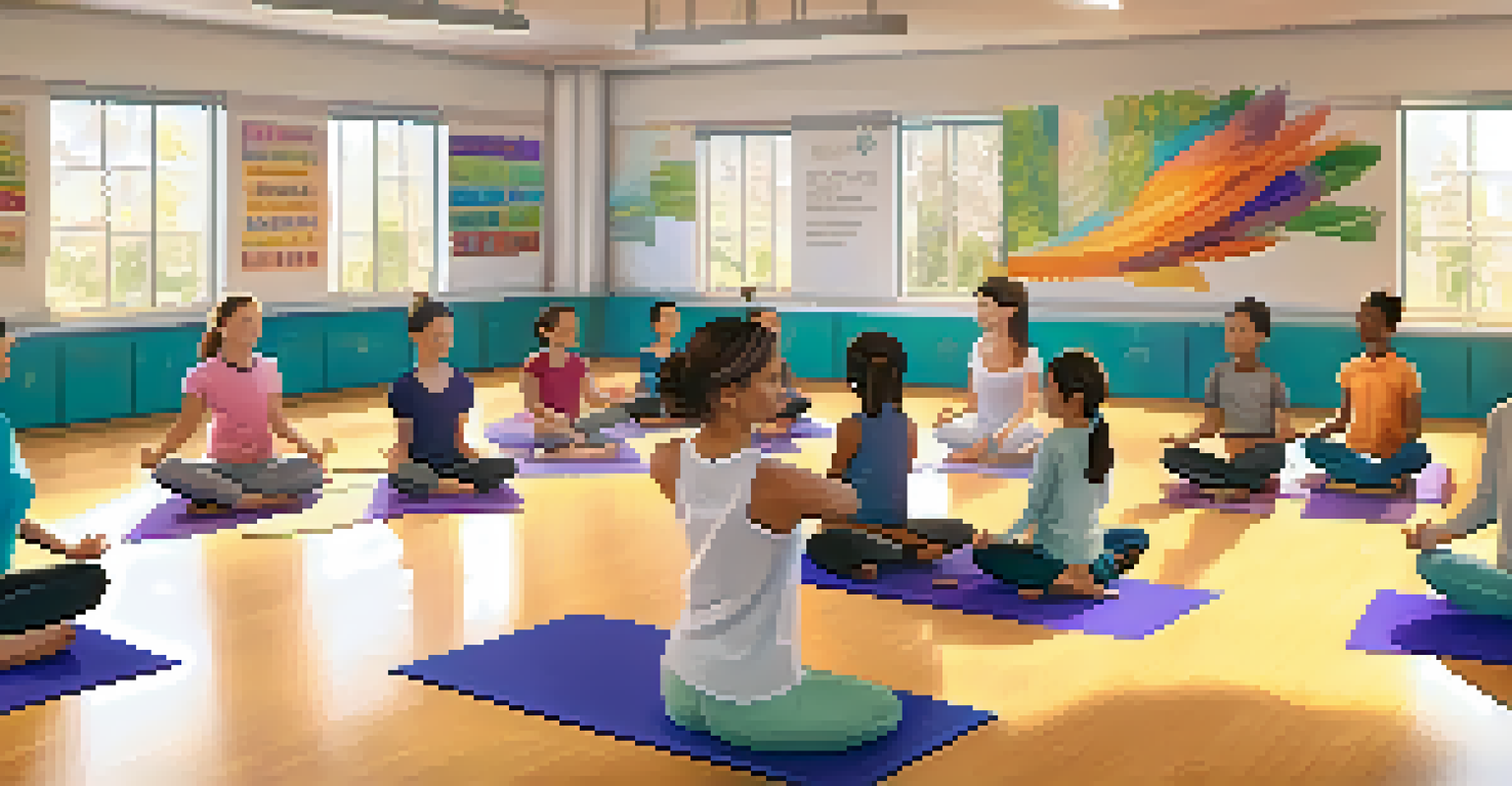Yoga for Social-Emotional Learning in Educational Settings

Understanding Social-Emotional Learning (SEL) in Schools
Social-emotional learning (SEL) is a framework that focuses on developing skills like self-awareness, empathy, and emotional regulation in students. These skills are essential for building healthy relationships and navigating social complexities. By integrating SEL into educational settings, schools aim to create a supportive environment where students can thrive both academically and personally.
The greatest weapon against stress is our ability to choose one thought over another.
Incorporating SEL into the curriculum helps students manage their emotions and make responsible decisions. It’s not just about academic success; it’s about fostering a holistic approach to education that nurtures the whole child. When students feel safe and connected, they are more likely to engage and succeed in their learning.
Many educators are recognizing the value of SEL in enhancing classroom dynamics and overall student well-being. For instance, schools that implement SEL programs often report improved student behavior and increased academic performance. This shift towards emotional intelligence in education is where yoga can play a significant role.
The Role of Yoga in Enhancing SEL Skills
Yoga is not just about physical postures; it’s a practice that promotes mindfulness, self-regulation, and emotional balance. These attributes align perfectly with the goals of social-emotional learning. Through yoga, students can learn to calm their minds, focus their thoughts, and connect with their emotions on a deeper level.

Engaging in yoga helps students develop resilience and coping strategies for dealing with stress. For example, a simple breathing exercise can empower a student to manage anxiety before a test. This practical application of yoga fosters emotional awareness and encourages students to express their feelings constructively.
SEL Enhances Student Well-Being
Integrating social-emotional learning in schools fosters a supportive environment that promotes both academic success and emotional health.
Moreover, yoga encourages a sense of community and collaboration in the classroom. Group yoga sessions can enhance social bonds, teaching students the importance of teamwork and support. As they practice together, they learn to respect each other’s space and feelings, which is crucial for building healthy relationships.
Benefits of Yoga for Students’ Emotional Health
The benefits of yoga for emotional health are profound, especially in the context of education. Studies have shown that regular yoga practice can reduce symptoms of anxiety and depression in students. When children learn to manage their emotions through yoga, they often experience improved mood and heightened self-esteem.
In the middle of difficulty lies opportunity.
Additionally, yoga promotes mindfulness, enabling students to stay present in the moment. This focus can lead to better concentration in class and a more positive attitude toward learning. As they become more aware of their thoughts and feelings, students can navigate challenges with greater ease.
By integrating yoga into the school day, educators can cultivate a more emotionally resilient student body. For instance, a short yoga session before a challenging subject can set a positive tone and prepare students mentally. This proactive approach to emotional health can lead to long-lasting benefits both in and out of the classroom.
Implementing Yoga Programs in Schools
Implementing yoga programs in schools doesn’t have to be complex or expensive. Many schools start with simple, short sessions led by trained instructors or even classroom teachers who are passionate about yoga. By incorporating yoga into existing physical education classes or as a stand-alone program, schools can easily integrate these practices into their routines.
Creating a welcoming and inclusive environment is key to the success of yoga programs. Schools can encourage participation by offering sessions that cater to different skill levels and backgrounds. This inclusivity not only fosters a sense of belonging but also allows students to experience the benefits of yoga without fear of judgment.
Yoga Boosts Emotional Resilience
Practicing yoga in schools helps students develop mindfulness, coping strategies, and emotional regulation, contributing to their overall well-being.
Moreover, involving parents and the wider community can enhance the impact of these programs. Workshops or family yoga nights can help to extend the benefits beyond school walls, creating a holistic approach to emotional well-being. When families engage with yoga together, they reinforce the lessons learned in school, promoting a culture of mindfulness and connection.
Training Educators in Yoga Techniques
For yoga programs to be effective, educators need proper training in yoga techniques and mindfulness practices. Professional development workshops can equip teachers with the skills to lead yoga sessions confidently. This training not only enhances their teaching toolkit but also supports their own emotional well-being.
As teachers gain experience with yoga, they can better integrate these practices into their daily routines. This might include starting the day with a few minutes of stretching or ending a lesson with a mindfulness exercise. Such small adjustments can create a more relaxed and focused classroom atmosphere.
In addition, having educators who are passionate about yoga can inspire students to participate more actively. When teachers model these practices with enthusiasm, students are more likely to engage and see the value in yoga. This creates a positive feedback loop that benefits everyone involved.
Measuring the Impact of Yoga on SEL
Measuring the impact of yoga on social-emotional learning can be a valuable tool for schools. Educators can use surveys and assessments to gauge changes in students’ emotional awareness, self-regulation, and interpersonal skills. By tracking these metrics, schools can understand the effectiveness of their yoga programs and make necessary adjustments.
For example, pre- and post-program surveys can help identify shifts in student attitudes and behaviors. Schools might find that students report greater feelings of empathy and improved conflict resolution skills after participating in yoga sessions. Such data can reinforce the importance of integrating yoga into the school curriculum.
Training Teachers for Yoga Success
Equipping educators with yoga techniques empowers them to effectively integrate mindfulness practices into the classroom, enhancing student engagement.
Moreover, sharing these findings with the school community can foster support for ongoing yoga initiatives. By showcasing the positive effects on students’ emotional health, schools can encourage more participation and resources for these programs. This commitment not only benefits students but also contributes to a more positive school climate overall.
The Future of Yoga and SEL in Education
The future of yoga in educational settings looks promising, particularly as the need for social-emotional learning continues to grow. As schools recognize the importance of emotional intelligence, integrating yoga can become a staple in promoting holistic development. This alignment prepares students not just for academic success, but for life’s challenges as well.
Innovations in teaching methods and curriculum design will likely continue to incorporate mindfulness and yoga practices. As educators become more aware of the benefits, we may see a rise in specialized yoga programs tailored specifically for different age groups. This evolution could lead to even greater accessibility for students in diverse educational settings.

Ultimately, the integration of yoga and SEL in schools has the potential to transform educational experiences. By fostering emotional well-being and resilience, schools can cultivate a generation of empowered, empathetic individuals ready to make a positive impact in their communities. This vision aligns perfectly with the goals of modern education, which values both academic and emotional growth.